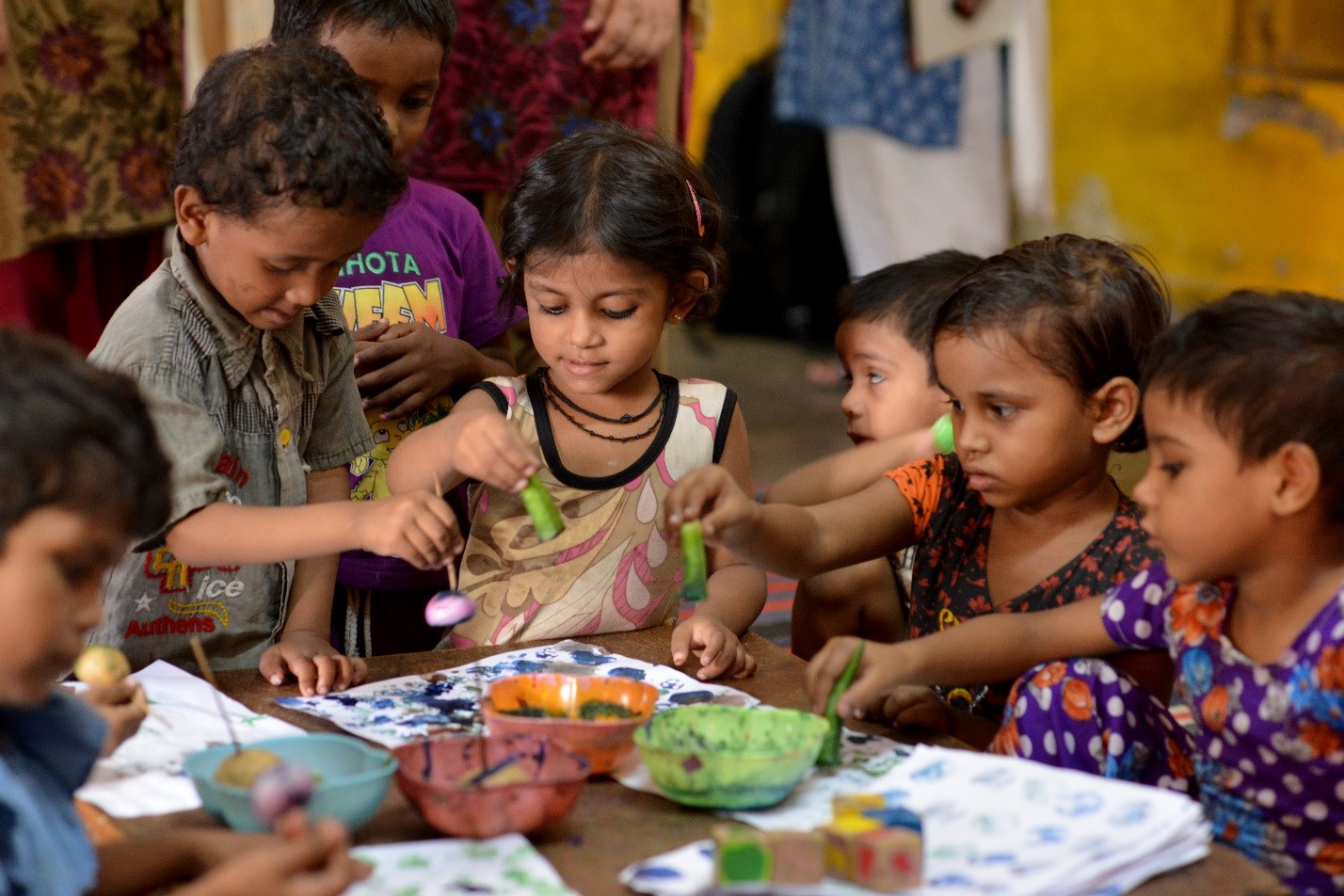Engendering Early Childhood Development in India

Introduction
Over the past decade, there has been a growing global focus on early childhood development. Quality childcare can provide children with lifelong health, education, and social development benefits. Women have traditionally been responsible for childcare, with little help managing it alongside their work, paid or unpaid. The responsibility of unpaid care work disproportionately impacts women’s access to education, employment, leisure, health, and well-being. It also reduces the availability of opportunities for remunerative employment. Women are frequently compelled to work in informal, unstable environments or quit entirely due to caregiving responsibilities. This unequal burden impacts women from all walks of life but disproportionately affects impoverished and underprivileged women. Policymakers in India need to address the unpaid care work women are obligated to perform. Establishing childcare centres, or creches, is a crucial policy tool for achieving this objective. This blog will look at state-sponsored creche policies and programmes and assess how well they work to help women find and retain jobs.
In India, care policies and legislation have long been influenced by the concept of “Gendered Familialism,” which places the responsibility of care work on women based on familial relationships (Neeta and Palriwala, 2011). Unfortunately, this strategy limits the pool of potential carers and care recipients, fails to acknowledge care as a shared public responsibility, and does not take into account the fact that women frequently require assistance managing both their paid work and care obligations, particularly with regard to childcare. Over the years, many legislative and policy initiatives have sought to address this mindset by attempting to redistribute care provision to employers and the government. These include early statutory provision of childcare in the formal sector, crèches provided at worksite in the informal sector under the Mahatma Gandhi National Rural Employment Guarantee Act (MGNREGA), the universalization of Integrated Child Development Services (ICDS), and the PALNA scheme, which mandates making crèches accessible for both employed and unemployed mothers (Chigateri, 2017). Although these government programmes and legal frameworks have touched on the need for childcare benefits to increase women’s labour force participation by providing daycare centres and maternity benefits, the execution of such mandates can be improved.
Tracing the History of Child Care Services
Childcare services have been recommended for working women in many government and non – government policy documents (Chigateri, 2017). For working mothers, ‘crèches, nurseries, and labor-saving devices’ were recommended in the 1974 report “Towards Equality” by the Committee on the Status of Women. The “Shramshakti” report from 1988 was another significant report, which acknowledged the right of working women to have access to child care. It also suggested childcare facilities for women working in the informal sector. Childcare services for women in both the formal and informal sectors were also advised in other policy documents. The 1988 National Perspective Plan for Women suggested that laws requiring companies to provide crèches for a certain percentage of female employees be changed to gender-neutral policies. Additionally, the 2001 National Policy for the Empowerment of Women recommended that childcare facilities be available in workplaces, educational institutions, and residences for the elderly and disabled.
Despite the strong emphasis on centre-based childcare services in several policy documents, progress towards implementing these recommendations has been slow in reality. Most legislation on the subject has only applied to women employed in the organized sector, leaving out a significant portion of the female workforce. Legislations such as the Factories Act 1948, Plantation Labour Act 1951, Mines Act 1952, Beedi and Cigar Workers’ Act 1966, Contract Labour Act 1970, Inter-state Migrant Workers Act 1980, and Building and Construction Workers Act 1996 mandate crèche facilities in the organized sector and workplaces with a relatively large number of women employees. Efforts to expand childcare options for women workers have been made in both organized and unorganized sectors through the Maternity Benefits Act (2017) and the National Rural Employment Guarantee Act (2008). The Maternity Benefits Act 1961, amended in March 2017, presents a mixed picture of state involvement in childcare provision (Chigateri, 2017)[1]. Although the Maternity Benefit Amendment Act extends the duration of wage replacement during maternity leave from 12 to 26 weeks, it also mandates establishments with 50 or more employees to provide creche facilities within a prescribed distance. The high threshold and the exclusion of women workers outside the organised sector drew criticism from women’s organisations.
In the Draft Rules on Social Security Code (SSC), which the Ministry of Labour and Employment published in November 2020, the condition of more than fifty employees in the Maternity Benefit Act (Amended), 2017, was changed to an eligibility condition of fifty “women employees.”, disregarding the needs of young children of all employees, both men and women workers (Mishra and Sachdeva, 2021)[2].
MGNREGA is the only act in the country that gives legislative support for childcare provisioning in the unorganized sector, recognizing both the work-related rights of women and their right to provide adequate nutrition and care for their infants. However, creches under MGNREGA have performed unsatisfactorily.
Another modality through which childcare provision was introduced in India was the Integrated Child Development Scheme (ICDS), launched by the Government of India in the 1970s. The programme was designed to promote early childhood development (ECD) in children under the age of six. It was the first government initiative to address young children’s nutritional, health, and early learning needs while also enhancing mothers’ capacity to meet those needs (Mishra and Sachdeva, 2021) [3]. The program focused on six comprehensive services: supplementary nutrition and growth monitoring, immunization, health check-ups, health and nutrition education, referral services, and non-formal pre-school education. This program was to be coordinated through Anganwadi Centres (AWCs) by Anganwadi workers and helpers. Over time, the program expanded to cover all blocks in the country. Children under the age of six now have a universal right to these services due to the Supreme Court’s order for the quality universalization of the ICDS. The ICDS has played a significant role in tackling malnutrition amongst children and mothers in the country. However, implementation of the programme has largely been reliant on mothers of children, perpetuating the notion that childcare is solely their responsibility and creating difficulties for employed women accessing services.
Furthermore, the pick-up and drop timings of AWCs frequently conflict with the mothers’ employment hours, necessitating the need for dependable childcare services. Also, the AWCs are only open for four hours, which is unhelpful for working women who put in much longer hours. In 2012, the Restructured ICDS document did recommend the conversion of 5 percent of AWCs in the country to Anganwadi-cum-crèches (AWCCs) but this has only been implemented in a limited number of AWCs.
The Scheme of Assistance Crèches for Working/Ailing Mothers was another way the government introduced childcare services for women. It was initiated in 1974 to offer creche services to the young children of female labourers living below the poverty line. The Rajiv Gandhi National Crèche Scheme (RGNCS) for Children of Working Mothers was created in 2006 as a merger of two previous crèche schemes: the aforementioned scheme and the National Crèche Fund Scheme established in 1995. The government runs the scheme in partnership with private sector and non-government organizations to target remote and underprivileged areas. It was later renamed the National Creche Scheme (NCS). Though important, this scheme restricted Creche facilities’ provision to working or ailing mothers.
Status of current schemes
As part of the recently approved Mission Shakti, the National Creche Scheme has been updated and renamed as Palna Scheme to provide creche services for children (6 months to 6 years old) of working mothers as well as to enhance the nutritional and physical well-being of kids. The scheme will offer working women’s children a safe and secure environment for their nutritional, physical, and cognitive development and inspire women to pursue their career opportunities. The Scheme provides Creche facilities for children of all women, whether employed or not. This denotes a progressive shift in the government’s perspective. This programme addresses the urgent need for high-quality childcare facilities. During the 15th Finance Commission, the government intends to establish an additional 17,000 Anganwadi cum creches under Palna. Despite its carefully considered formulation, the secret to its success will be in how well it is put into practice. The programme’s effectiveness will be ensured by increasing the network of childcare facilities and allocating sufficient financial resources in that direction. It is critical that the planning, designing, execution and monitoring of these schemes and programmes actively adopt gender intentionality in their approach to ensure that care work ceases to pose a challenge to women’s social and economic well-being.
Author: This blog is authored by Divya Singh, Research Manager at IWWAGE
[1] Palriwala, R. and Neetha, N., 2011. Stratified familialism: the care regime in India through the lens of childcare. Development and Change, 42(4), pp.1049-1078.
[2] Chigateri, S., 2017. ”Pathways to Accessible, Affordable and Gender-Responsive Childcare Provision for Children Under Six-India Case Studies.
[3] ibid
[4] Committee on the Status of Women. 1974. ‘Towards Equality’. New Delhi: Ministry of Education and Social Welfare, Government of India
[5] Government of India, 1988. Shramshakti: Report of the National Commission on Self-Employed Women and Women in the Informal Sector
[6] ibid
[7] Mishra, S and Shubhika Sachdeva in Agrawal, N., 2021. Her Right To Equality: From Promise to Power. Penguin Random House India Private Limited.
[8] ibid
- Posted In:
- Latest Blogs






















































Leave a Reply